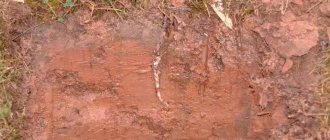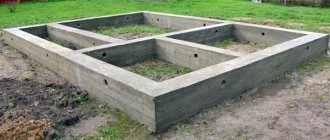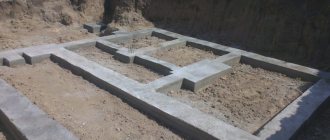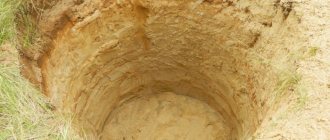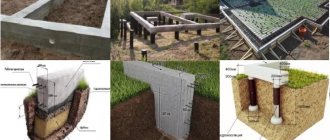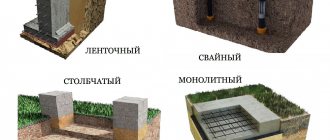In the process of designing a building, the choice of foundation is one of the most important issues, and here many have to decide for a long time and painfully which is better: a monolithic slab or a strip foundation. Just a few years ago there was no such choice - for individual low-rise buildings, a strip foundation was traditionally considered the best option, but today developers increasingly prefer a slab.
A reliable and durable foundation is the guarantee that the building will last for many years, will not require repairs, will retain its original characteristics, and will withstand the pressure of external negative factors. The strip foundation is considered the simplest and cheapest to make, reliable and durable. At the same time, when studying the features and advantages of the monolithic option, many prefer it.
Below is a detailed discussion of the advantages and disadvantages of both types of foundation, their comparison and results.
What is a strip foundation
When thinking about which is better: a strip foundation or a monolithic slab, it is worth carefully studying each option separately. A strip foundation is a support for internal/external load-bearing walls, which is made in the format of a thickened strip immersed in the soil. It is the tape that takes on the weight of the structure and is responsible for uniform distribution of weight, transferring the entire load to the soil layers.
The main parameters when constructing a strip foundation are the depth of the structure, its height and thickness. All this is designed in accordance with the groundwater level and soil characteristics.
The main factors influencing the soil on the tape:
- Uniformity, composition
- Passage level and volume of groundwater layers
The factors are interrelated and are always studied in the process of performing calculations in a complex. The most difficult soil is considered to be clay, which does not allow water to pass through, but instead accumulates it in the pores and causes the risk of heaving in winter. Heaving loads affect different zones of the foundation unevenly; the forces are not constant, appear alternately, causing deformation.
To build a reliable and high-quality strip foundation on difficult soil, it is buried below the winter freezing limit of the soil. Then the heaving load can be avoided, but, in turn, the side surface of the tape begins to feel significant forces in the horizontal plane. To reduce such loads, you can make a shallow foundation that sinks to a maximum of 0.5-1.5 meters.
In this way, it is possible to reduce horizontal loads and compensate for the forces from below with the mass of the structure itself, the absence of the risk of freezing of the house due to heating in the building, and a layer of sand cushion that works as drainage and compensates for heaving.
The design and calculation of the strip foundation, the implementation of the project are quite simple and understandable, there are no particular difficulties in the process. In this case, it is possible to minimize the risk of miscalculations in the project and errors in implementation, and eliminate the risk of destruction of the building due to illiterate construction.
Advantages and disadvantages
When trying to decide whether a foundation or a slab is better, you should pay attention to the main advantages and disadvantages of both types. As a rule, considering the strengths and weaknesses of the options is enough to determine the best option for a particular case.
The main advantages of a strip foundation:
- High load-bearing capacity
- Reliability and durability
- Resistance to various external loads
- Cost-effectiveness and simplicity of all stages of construction
- The ability to choose the best option from several, in accordance with the conditions and requirements
- A chance to create a reliable cellar or basement if desired
Among the disadvantages it is worth highlighting: the need to first carefully examine the soil, study the composition, all the features. You should also remember about the significant amount of excavation work, often involving special equipment. The mass of the tape itself is quite large and is located on a narrow line, often causing soil subsidence due to errors in construction or insufficient soil research.
Despite the impressive list of tape disadvantages, when choosing which foundation is better (strip or slab), it is worth considering that almost all types of foundation have similar features and disadvantages. Therefore, they are successfully leveled out by knowledge and calculations.
Kinds
Strip foundations are classified according to several criteria. The main ones are the depth of the base and the design of the tape itself.
Types of foundation according to laying depth:
- Non-buried foundation - almost the entire tape is at the top. Relevant for rock slabs, dense dry soils, when immersing the structure in the ground is impossible or unjustified. The rarest type of tape, found only in some regions.
- Shallow – suitable for slightly heaving/non-heaving dry soils. An ideal choice for small buildings, low-rise individual construction.
- Recessed – the tape is suitable for massive large buildings, provides maximum load-bearing capacity, strength and reliability. But it involves a significant investment of time, effort, and money for construction materials and land work.
When trying to decide what to choose (strip or slab foundation), you must take into account the design features of different types of foundations, which can vary significantly.
What types of tapes are there by design:
- Prefabricated foundation
– consists of individual foundation blocks, any stone, standard brick, etc. Suitable only for non-heaving soils where there are no deforming loads. The most durable is considered to be a tape made from foundation blocks, since the smaller the size of the fragments, the lower the resistance of the tape to deformation. The high speed of construction makes such a foundation popular in certain conditions.
- Monolithic foundation
– performed in the format of a continuous strip of reinforced concrete. Provides maximum load-bearing capacity and strength, and is highly resistant to loads due to soil heaving. Among the disadvantages, it is worth highlighting the need to wait 28 days until the concrete gains strength characteristics and construction can continue.
- Combined
– two types of support are used, different design options for the sole and the supporting element of the base. One of these types can be considered a pile-strip type of foundation, where the piles guarantee contact with stable/dense layers of soil, and the tape absorbs and evenly distributes the loads from the load-bearing walls.
What conditions is it suitable for?
A strip foundation, unlike a slab foundation, best demonstrates all its properties and is justified when building in stable, dry, dense soils with low-flowing groundwater. When the soils are problematic, the bearing capacity of the tape decreases and there is a need for the correct implementation of various additional measures (creating a footing, increasing the cushion layer, drainage, etc.).
The use of strip foundations in thick heaving soils is limited (only if the calculations are correctly performed to justify such a choice).
The foundation tolerates low temperatures well, but is afraid of condensation and groundwater, requiring mandatory insulation and waterproofing measures. However, despite all the nuances, for most regions of the country it is the strip foundation, as opposed to the slab foundation, that is becoming the current choice. This speaks to its reliability and versatility.
Scope and calculation features
The main purpose is to use it as a foundation on soft soils with a maximum load-bearing capacity of up to 2.5 kg/cm2. This includes sands - silty and medium density, clays and plastic loams, peat and moist soils. Moreover, it is the level of soil moisture that largely determines its load-bearing capacity - when wet, it literally “floats”, losing its strength properties. Therefore, drainage, waterproofing and blind areas play an important role in the arrangement of this type of foundation.
Reliable waterproofing is an important component of any foundationSource olestnicah.ruOne of the advantages is often given the argument that you can make a monolithic slab with your own hands. But even if we do not consider the issues of choosing the type of concrete and the parameters of the reinforcement frame, such an important stage remains as calculating the dimensions of the slab. And if there is a certain clarity with the area (the size of the house plus a small margin on each side), then the thickness of the slab is not easy to calculate.
But this range also includes “light construction” in the form of a garage or summer kitchen, and a two-story house with an attic. If you make the slab not “thick” enough or choose the wrong thickness of the reinforcing rod (or cell size), then it will not be able to withstand the total load. An excessive margin of safety leads to an increase in the cost of an already expensive foundation, and an excessive amount of concreting will make the entire structure heavier, and the soil may not be able to withstand the total load.
There is another option with a diametrically opposite scope of application - the slab is installed on rocky and coarse soils with very high load-bearing properties. In this case, it rather levels the construction site rather than redistributing the load from the structure.
Another feature of this foundation is that the laying of pipelines must be done at the zero cycle stage. Source xpcenter.ru
What is a monolithic slab
A monolithic foundation is a solid slab of reinforced concrete, which becomes the basis for the future building. The plate does not create a large load, because due to the significant area, the specific pressure is small. In case of soil movements, the concrete pad with the house easily moves along the ground, but a rigid and durable slab guarantees the reliability and levelness of the building.
To construct this type of foundation, a pit is dug, removing the top layer of soil. Then they fill in a sand cushion, level it, compact the layer, and put geotextiles and insulation on top. Next, the formwork is installed and a reinforcement frame is formed in it, which is filled with concrete.
After 28 days, the concrete gains strength and the result is a reliable, durable, well-insulated and protected base, capable of accepting loads from the building and resistant to various soil movements.
Advantages and disadvantages
Before deciding which foundation is better (strip or slab), you need to study the soils and conditions at the site, consider each suitable option in terms of implementing the assigned tasks and improving the quality of construction, reducing the cost of the project.
The main advantages of a monolithic foundation:
- Good strength and reliability indicators on heaving, weak-bearing, water-logged soils
- High load-bearing capacity of the base - even heavy large buildings are strong
- Provided proper reinforcement, the foundation successfully withstands any influences
- Easy perception of ground movements - due to the fact that the slab seems to “float” on the surface
- Ease of construction - serious mistakes in construction are extremely rare
- Pouring the slab makes it possible to immediately get half the floor, further work is simplified
Among the disadvantages, it is necessary to mention: the lack of the possibility of creating a cellar or basement, eliminating the chance of repairing the slab, a large amount of excavation work and a significant consumption of building materials. Due to these disadvantages, a foundation slab is usually an excellent choice where there are no alternatives.
Varieties
Reinforced concrete slabs can be made using several methods, using various technologies.
Types of slab foundation:
- Monolithic slab - poured on site
- Prefabricated - assembled from ready-made reinforced concrete blocks, which are laid on a previously prepared site
Types of slab construction:
- Solid – well suited for small light buildings
- Ribbed - with special stiffening ribs that secure the structure in the soil and do not allow it to move in space. The ribs also help distribute the entire load more evenly
- Box - in such a slab, the floor of the first floor is made in the form of a separate ceiling, while the surface of the slab creates a basement room
Suitable conditions
When thinking about which foundation is better (strip or monolithic), first of all, the conditions at the site and the type of soil are taken into account. Slab foundations are relevant for the construction of buildings in regions with heaving, unstable, and water-logged soils.
This is a good alternative to piles when it is not possible to use special equipment on site. Also, a slab base can be poured where dense layers of soil lie very deep (and the length of the piles is simply not enough).
Situations of preference
Let's consider the main situations when you should prefer pouring or laying foundation blocks.
- A buried foundation with an average load on the structure (one-story houses made of brick, stone, cinder block or higher-rise ones made of foam concrete) can be made from FSB. For more massive buildings, it is preferable to pour a monolithic foundation.
- In most regions, it is better to fill a shallow foundation with the creation of a reinforcing frame. Only in regions with stable soils can blocks or even natural rubble stone be used.
- Sometimes it is advisable to combine two technologies. This means laying FSB with the creation of a reinforcing monolithic armored belt on top of it.
As you can see, each method of constructing a foundation strip has advantages, as well as disadvantages.
Considering the importance of creating a solid foundation during the construction process, it is advisable to take a balanced approach to the choice of technology and material, resorting to the help of professionals who would calculate and take into account all the nuances in a particular situation
Which one is better
When raising the question of which option is better - a slab or a strip foundation, you need to understand why and where the foundation is created. Comparing the characteristics of a plate and a tape is incorrect, since they are designed for different tasks.
The slab is able to float freely on unstable soils - where the tape will not provide the required strength and the building may simply deform. A strip foundation, built in suitable conditions, is much more economical and cheaper than pouring a slab.
After carrying out hydrogeological surveys and calculating the loads that a building made of one material or another will produce, the choice will be easy to make.
Comparison
To determine which is better, a monolithic slab or a strip foundation, we will compare structures according to such indicators as:
- construction cost;
- reliability and durability;
- simplicity and speed of construction.
However, it should immediately be noted that the comparison of the two fundamental technologies cannot be called correct. The use of strip structures is limited by the presence of weak, unstable soils, and the high costs of installing a floating slab are not justified on dense, immovable soils.
Which is cheaper?
Construction practice shows that strip foundations, especially when shallowly buried, are several times cheaper than a reinforced concrete monolithic slab. This is based on less excavation work, construction materials consumption and labor costs. Therefore, if possible, builders always choose a strip-type foundation, since it is more profitable .
Which is more reliable?
The reliability of the foundation depends on the type of soil, the depth of its freezing and the upper level of groundwater. Strip foundations without additional reinforcement cannot be built on heaving soils and wetlands. A monolithic slab-type foundation can be installed under almost any conditions. Therefore, it can be considered more reliable.
What will last longer
Experts say that a monolithic reinforced slab can serve as a foundation for up to 150 years. However, construction companies rarely provide a guarantee for slab foundations for more than 25 years. Precise data and examples are not yet available, since this technology was developed relatively recently.
The strip base does not take well both vertical and horizontal soil displacements. Therefore, contractors provide a 30-year guarantee for prefabricated strips, and 50 years for reinforced concrete monoliths.
What is built faster?
When pouring a monolithic strip or slab, a large amount of time is spent on the process of hardening and gaining sufficient strength of the concrete. It is true that the use of ready-made foundation blocks or floor slabs can reduce construction time, but such structures are less reliable.
In both cases, installation of formwork, assembly of reinforcement cage, waterproofing and pouring of the mixture are required. Therefore, we can say that the speed of construction of both types of foundation depends on the length of the walls and the building area .
Which type is built faster?
In terms of production speed, it is not so much the types of foundation that differ, but the types of structures. Pouring the slab and strip with concrete requires a period of time for the material to gain strength - the total period is 28 days. During this time, all work must stop. In addition, concrete structures can only be poured in warm weather.
If a prefabricated slab foundation is created from ready-made reinforced concrete blocks, the construction time is much reduced. It is also important that prefabricated structures can be installed at any time of the year.
As for the volume of work, a slab foundation has certain advantages - less time is spent, the process is more efficient. When making a slab foundation, a floor is immediately created on the soil, and the weight of the structure is distributed more evenly and over a larger area.
Flooring options
There are many options for creating a floor on a monolithic slab. The main task is to insulate the slab and ensure a high-quality microclimate inside the house.
Most experts consider the optimal composition of the floor pie to consist of the following layers:
- Layer of sand.
- “Skinny” screed 5 cm.
- A layer of insulation (penoplex 5 cm).
- Concrete screed giving strength (5-7 cm).
- Leveling screed (2-3 cm, ready-made compounds).
- Final (finish) coating.
At the same time, if the slab is sufficiently insulated from below, simpler methods can be used. For example, a “floating” floor consisting of a layer of sand backfill (as an option, you can use fine expanded clay, which provides additional insulation) and sheet materials installed on top (chipboard, plywood, MDF, etc.).
The backfill layer is carefully leveled flat and horizontal, a subfloor made of sheet materials is laid on it, then the finishing coating is installed.
There are other options for arranging the floor, but they all represent different combinations of laying layers of backfill, insulation, and leveling screed. They have no fundamental difference or significant advantage, having approximately equal performance qualities.
Soil types
When deciding which is better (strip foundation or slab), be sure to take into account the type of soil. The slab base can be mounted on any type of soil, it is almost universal.
A strip foundation can be designed exclusively on non-heaving or slightly heaving soils. In difficult conditions, the structure loses efficiency and can cause deformation of the building.
What is their service life?
A foundation made of a monolithic reinforced concrete slab can last up to 100 years - at least, experts indicate this is the maximum period. On the other hand, contractor companies implementing various projects provide a guarantee for the building from 15 to 30 years. At the moment there is no precisely confirmed data.
Strip foundations have been studied much better - many examples of finished houses prove that a building on such a foundation can stand: 50-75 years for a structure made of FBS, 30-50 years for a brick foundation. If the tape is made of concrete, it can last up to 150 years.
Price issue
A monolithic slab on a strip foundation is reliable, wear-resistant, durable, but in the review we have not yet considered the issue of price. Dependence on the volume and complexity of the work is a relative concept, but in this case they most clearly reflect the price of the finished solution.
When calculating, the following parameters are taken into account:
- concrete screed thickness;
- thickness of the sand and gravel cushion;
- number of insulating materials;
- reinforcement diameter or quantity of reinforcing mesh;
- height of the poured foundation;
- volumes of lumber used for formwork.
The number of materials used depends on the area of the monolithic slab. With a thickness of 20 cm, the price will be around 4,000 rubles, with a thickness of 40 cm – 6,500 rubles.
The cost of a ready-made solution is determined by the climatic and geological conditions of the region. These include the proximity of groundwater and the complexity of the terrain. When contacting specialists, you need to take into account the price of construction services - it is calculated per shift or per result.
The price of the foundation depends on the thickness of the slabs and the amount of materials usedSource propodval.ru
Concluding contracts with construction companies for the implementation of a turnkey project is much more profitable than contacting one or more private teams. In the first case, the quality of the work will be guaranteed to be high, it provides a guarantee. Be sure to carefully read the terms of the contract with all the specified details of cooperation. The price is calculated in advance before the contract is concluded.
Summarizing
Despite the many advantages of the slab, today the strip foundation remains more popular due to its ease of construction and low cost. The tape costs less, is easier to perform, has been studied better, but construction requires more time. The only negative is the ineffectiveness of strip foundations in non-heaving and unstable soils.
The slab foundation is universal, suitable for any type of soil. It costs much more, is installed faster, and guarantees strength and reliability. But due to the fact that this type of base is less common, the expected service life and properties on different soils are still not very well understood.
When choosing between two types of foundation, you need to focus on the type of soil, the features of the object, the availability of finance and the project of the future building itself.
conclusions
Thus, we see that the slab foundation “won” this comparison. And in many characteristics it is superior to the tape type of base.
True, most developers do not think so, and prefer to build houses the old fashioned way, on a “ribbon”. The main argument: since everyone is building a strip foundation, it means it is the best, because if the “slab” was better, they would only build on it.
There is also a psychological aspect. Homeowners usually don't like to admit that they made mistakes during construction. And if a professional builder made a mistake, then the truth will never be known.
This is especially strange, given the increased accident rate of stone country houses in our time, since, in order to save money, people are increasingly trying to build such foundations on their own without complying with any standards.

